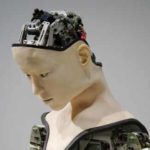Artificial Intelligence Boon or Bane?
by Dave Trecker
Computers will autonomously take your orders, prepare your food, deliver your purchases, run factories, operate
trains, buses and merchant ships, and make millions of decisions with little or no human input. It’s barely a decade away. There’s no question artificial intelligence will change the way we live. But will it change it for the better?
Some see an apocalypse with machines stealing our humanity and destroying millions of jobs. The late physicist Stephen Hawking said AI could “spell the end of the human race.” Entrepreneur Elon Musk said AI research is like “summoning the demon.” People will be left obsolete and jobless. The consulting firm McKinsey & Company estimates one third of the American workforce will be replaced by robots by 2030. Over 95% of farm jobs will be automated, and machines will replace 88% of construction workers and 79% of truck drivers. Robots will take over 20% of white collar jobs. Frightening stuff. Just what is AI – this phenomenon that can beat humans in chess and see deep into the future?
In the making for over 50 years, according to a Ted Greenwald Wall Street Journal article, AI is based on machine-learning algorithms called neural networks modeled on biological neurons. Digital neurons are arranged in interconnected layers, each sending its output to the next. A network with many layers is said to perform deep learning.
According to Kai-Fu Lee, former president of Google China, AI’s main advantage over humans is its ability to detect subtle patterns in huge quantities of data and learn from those patterns and adapt. Drawing on near limitless computing power, AI can perform rote functions: building cars, processing orders, sorting and correlating data, any of some 40,000 skills. With enough picture or music recognition, it can mimic Picasso or Beethoven.
But it can’t strike off in new directions. It can’t devise a new genre painting, create new harmonies, or carry out free-form conversations. It can’t truly think for itself……yet. But that may be coming. IBM, Intel, Qualcomm and a host of
other high-tech companies are broadening the scope of algorithms and speeding computing and response times. The sky may indeed be the limit. Here are some of the prospects:
• Fully automated retail stores where orders are taken, purchases processed, and services rendered based on facial
recognition.
• Chemical and drug research sped up 10-fold or more, providing groundbreaking new products – everything from
cost effective solar panels to cures for Parkinson’s disease.
• Future wars run by computers processing 100,000 variables a second, reacting to missile strikes and weapon redeployment in real time.
• Transportation entirely automated, with self-driving and self-navigating trucks and ships delivering goods worldwide,
offloaded in automated warehouses and ports and distributed by self-driving vans and drones.
We’re well on our way. Already much routine manufacturing is carried out by AI-directed robots. (China has installed over 90,000 robots in its factories.) Self-guided cars are becoming commonplace. Robot baristas in Shanghai serve up everything from double espressos to dry martinis. Drug discovery is being aided by supercomputers that sort vast repositories of data. An international retailer in California processes sales orders with machines that speak six different languages and work around the clock.
But the $64,000 question remains: Will AI create or destroy jobs? Most say the answer is both. Jobs requiring routine,
repetitious activity will be lost. But new jobs to harness and manage AI will be created. The consulting firm Cognizant Technology Solutions sees at least 21 new job categories being created, many based on designing
and running AI networks. Somebody has to build and manage the robots. WSJ says millions of additional coders and software developers will be needed. Someone has to organize the massive data lakes that feed AI. And someone has to “label” that data, direct it to tasks like facial recognition and autonomous navigation.
On a more mundane level, new government positions will be needed to craft rules. Self-driving buses will have to be permitted. Flocks of drones and the airspace they occupy will have to be regulated. McKinsey predicts AI will lead to a net gain of at least 20 million new jobs globally by 2030. And it could be as many as 50 million. Productivity boosts of 2% or more per year will drive GDP growth for the foreseeable future. Kai-Fu Lee writes, “AI’s advances will generate $15.7 trillion in additional wealth for the world by 2030.”
So don’t disable your fast food robot or throw sand into the gears of your neighbor’s self-driving car. It’s all going to turn out okay. Not only will AI boost growth, but with machines doing the scut work, more people will be freed to help in their communities, volunteer for charity work, or even take up pickleball or abstract painting.
A pretty good outcome.



Leave a Reply
Want to join the discussion?Feel free to contribute!